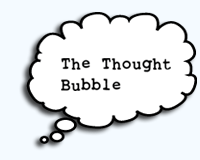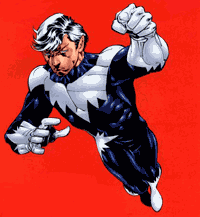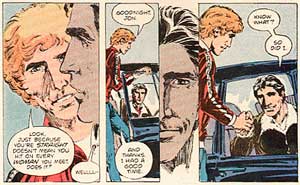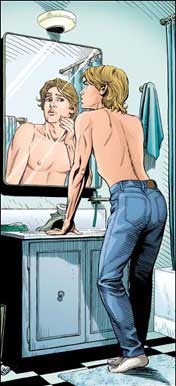Comics /
Cult Favorite
Sexuality in Comics
By
Philip Schweier
April 15, 2004 - 08:09
 Sexuality in Comics
Sexuality in Comics
 I forget the show, but on a TV sitcom a woman asked her husband, “Do we have enough gay friends?” His response was “To do what?”
I forget the show, but on a TV sitcom a woman asked her husband, “Do we have enough gay friends?” His response was “To do what?”
Joking aside, I think it’s a valid thought from a writer’s point of view. The notion of making a character gay for the sake of being gay is akin to affirmative action. It’s all well and good to have diversity in one’s cast of characters, but unless it serves the story in some way, I don’t particular care who is gay or straight.
Writer Judd Winick has come under fire on internet message boards. While not gay himself, Winick is greatly influenced by his friendship with Pedro Zamora, a former castmate of MTV's The Real World who tragically died of AIDS at the age of 22. Winick has written a number of characters with alternative lifestyles, most notably that of Terry Berg in the current Green Lantern series. This has resulted in Winick being accused of having a gay agenda, and criticism that he is expected to introduce more homosexual characters in each title he writes.
With Winick writing Outsiders and Green Arrow, and an upcoming Batman arc, the question on many readers’ minds is what gay characters will he introduce, or will someone come out of the closet? Hints have been made at Connor Hawke’s orientation in the pages of Green Arrow, but ultimately, what difference does it make?
 One argument is that it’s a tired gimmick on the part of Winick that does nothing to strengthen the narrative. The opposing side of that viewpoint is that homosexuality may be more common than we may realize, so for some characters to be gay is expected.
One argument is that it’s a tired gimmick on the part of Winick that does nothing to strengthen the narrative. The opposing side of that viewpoint is that homosexuality may be more common than we may realize, so for some characters to be gay is expected.
Whether Winick features gay supporting characters or not is a moot point. It’s nothing that hasn’t been done before. Back in 1984, Mike Grell’s Jon Sable, Freelance introduced Grey Adler, a gay man depicted with respect and intelligence.
Nevertheless, I do not believe that Grell or Winick have had any other agenda than to tell a good tale. Such roles can be germain to the story, and are an honest representation of the nature of the character. Rendering an accurate potrayal of specific social groups on the printed page can be frought with peril. Sensitivity toward another's differences, cultural and otherwise, is to be applauded, but only so long as one does not pander toward a segment of society or become patronizing. It is the responsibility of writers of any medium to open the minds of readers to a more truthful depiction.
 With that in mind, I feel the comics industry, as well television and film, are doing their audience a disservice in making much ado about a character's sexuality. During the height of his talk show’s popularity, Arsenio Hall was criticized for not having more gay people on his show. His response was that whether a performer is gay or straight is unimportant compared to their “star quality.”
With that in mind, I feel the comics industry, as well television and film, are doing their audience a disservice in making much ado about a character's sexuality. During the height of his talk show’s popularity, Arsenio Hall was criticized for not having more gay people on his show. His response was that whether a performer is gay or straight is unimportant compared to their “star quality.”
The same is true in comics. A fictional character’s supposed sexual preference is only one facet in their role. While some may lament that there aren’t enough or too many, my question to such people is “How do you know? What have you seen that tells you the intent of the writer?”
In a crowd scene, as Galactus attacks New York City, we as readers are unable to single out the sexuality of individuals, nor should we even try. Ultimately, these are fictional characters whose sexual orientation is no more the concern of the reader than that of our friends and neighbors. In a fictional world, the only events that exist are those depicted by the writer, and even those are suspect.
My expectation is that a writer merely to tell a good story, one that I can enjoy over and over. •
Praise and adulation? Scorn and ridicule? Email me at philip@comicbookbin.com.
Past Articles by Philip Schweier
Ande Parks: Railroaded Into Writing
Giving Super-Heroes their Props
Everything Is Old Again
The Bristol Board Jungle: A Review
Tales From The Bristol Board Jungle!
Remembering Julie Schwartz
Sequential Art at SCAD
Submissive Mail
Hitting the Motherlode in Utah
Wiping Out on the Wave of Nostalgia
Will Lightning Strike Twice?
Euro Comics
State of the Market
This is your captain?
The Incredible Hulk DVD Collection
DC vs. Marvel
Death, Take a Holiday!
Looking In on The Outsiders
News Bytes From The DC Universe
A Whole lot of Chaykin Goin' On
Superman/Thundercats (no, I'm not kidding)
Rucka Retires...
Why Jim Steranko Deserves all the Awards he Can Get
Are Trade Paperbacks the Future of Comics?
Crisis in the Infinite Continuity
How old is Batman?
Humour in Comics
Why Kids Don't Read Comics?
Superman Who?
Last Updated: November 29, 2025 - 16:51
 Sexuality in Comics
Sexuality in Comics
 I forget the show, but on a TV sitcom a woman asked her husband, “Do we have enough gay friends?” His response was “To do what?”
I forget the show, but on a TV sitcom a woman asked her husband, “Do we have enough gay friends?” His response was “To do what?”
 One argument is that it’s a tired gimmick on the part of Winick that does nothing to strengthen the narrative. The opposing side of that viewpoint is that homosexuality may be more common than we may realize, so for some characters to be gay is expected.
One argument is that it’s a tired gimmick on the part of Winick that does nothing to strengthen the narrative. The opposing side of that viewpoint is that homosexuality may be more common than we may realize, so for some characters to be gay is expected.
 With that in mind, I feel the comics industry, as well television and film, are doing their audience a disservice in making much ado about a character's sexuality. During the height of his talk show’s popularity, Arsenio Hall was criticized for not having more gay people on his show. His response was that whether a performer is gay or straight is unimportant compared to their “star quality.”
With that in mind, I feel the comics industry, as well television and film, are doing their audience a disservice in making much ado about a character's sexuality. During the height of his talk show’s popularity, Arsenio Hall was criticized for not having more gay people on his show. His response was that whether a performer is gay or straight is unimportant compared to their “star quality.”
